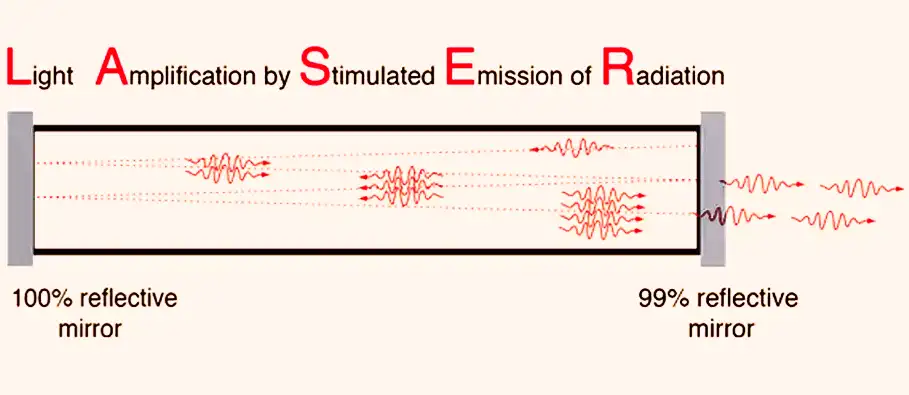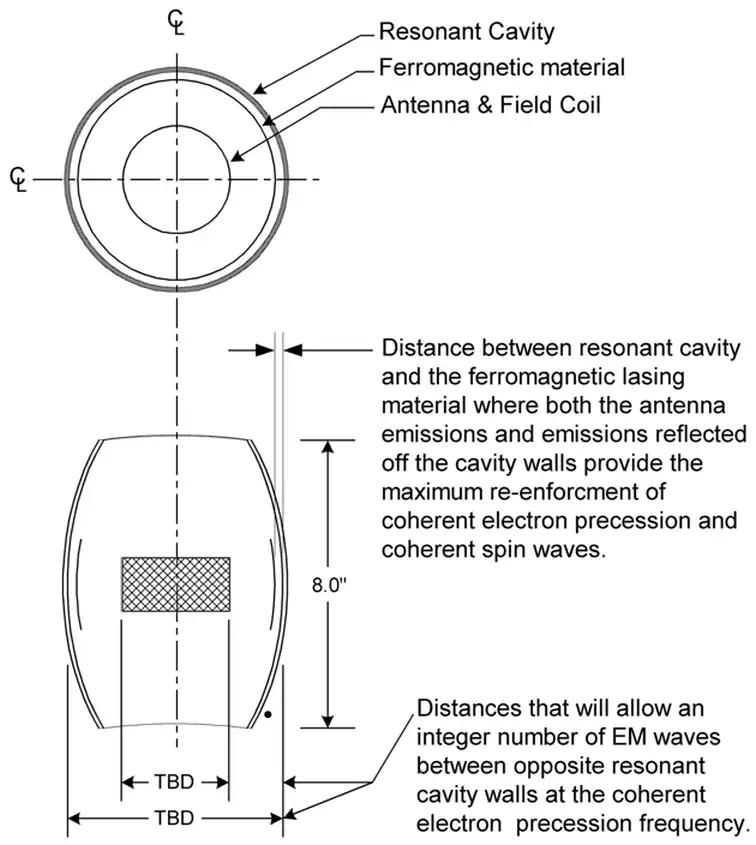|

Traditional Laser
hyperphysics.phy-astr.gsu.edu
/hbase/optmod/qualig.html#c2
|
|

Spinwave Laser (Maser actually)
|
It may be easiest to explain this with a comparison between a simple traditional laser and a simple spin wave laser (maser actually).
In a traditional laser, photons (discrete amounts of energy in the form of electromagnetic waves) are emitted when electrically charged particles move in step transitions from a location of higher potential energy to a location of lower potential energy. The amount of energy emitted as photons equals the difference in energy states. These events are stimulated to occur by other photons such that the emitted photons are in phase with the stimulating photons. These in turn stimulate more and more photons to be released from more charged particles that are in higher energy states as they fall to lower energy states.
Often electrons in orbitals around atoms are used. It is first necessary to have a population of electrons that are in higher energy states awaiting a stimulus to fall to a lower energy state. This is called a population inversion. There are various ways to get the electrons to move to orbitals that are of a higher energy state. One way is the pump in energy in the form of incoherent light, which are just electromagnetic waves of a variety of phases, frequencies and polarizations. Many electrons absorb this energy and move to higher energy state orbitals.
In the particular lasing materials used, these electrons have a natural tendency to fall to an orbital that is a lower energy state for the electrons but not their original lowest energy state. This intermediate state is called a metastable state and while in this state an external stimulus can cause the electrons to fall back to their original energy state. Now photons can stimulate the electrons to fall and at the same time emit photons themselves. These in turn stimulate more and more photons to be emitted. The photons are emitted in phase with the stimulating photons such that their amplitudes add together.
Here perhaps are better descriptions:
Federation of American Scientists/DOD/Navy/Laser Fundamentals
and here:
http://science.howstuffworks.com/laser1.htm
In a traditional laser, electrons will radiate photons (energy in the form of electromagnetic waves) from changing position in space from higher energy orbitals to lower energy orbitals. A spin wave laser (magnon laser) is based on the emission of energy in the form of electromagnetic waves from electrons with axial and orbital spin that transition from higher energy spin states to lower energy spin states. A magnon is a quasiparticle for the smallest quantum of spin wave energy similar to how a photon is the smallest quantum of light energy. In a magnetic material, if each spin orientation and associated magnetic dipole is not aligned with an external magnetic field then there is potential energy stored in that difference in orientation. When each individual magnetic dipole orientation moves to align with the external magnetic field this is a lower energy state. The energy lost is often described as propagating away through direct spin-lattice coupling but the energy lost can be made to radiate away as electromagnetic waves. This energy is lost as heat in a magnetic material where lasing is not occurring.
Similar to a tradition laser, it is first necessary to create a population inversion in which a large number of spins are in a metastable spin state. In this case, the metastable state is a higher energy state in which there is a natural tendency of the individual spins to reorient to a direction that is a lower energy state but they must first receive some stimulus to initiate the event. This is all related to the hysteresis characteristics of the particular magnetic material used as the lasing medium. Normally when a magnetic material is re-magnetized in some new direction the process occurs as disorganized avalanches of more and more magnetic domains until the whole sample is re-magnetized in some new orientation. In a spin wave laser this process involves a very ordered avalanche of spins transitioning to lower spin states.
In a spin wave laser with a population inversion of spin states, the individual spins will precess like little gyroscopes or tops. The stimulus to drop to a lower energy spin state comes in the form of electromagnetic waves that match the frequency of precession -- the Larmor frequency. The spins are stimulated to emit electromagnetic waves that are in phase with the stimulating electromagnetic waves.
Unlike a traditional laser, the phase of the simulating electromagnetic waves is more of an issue when the electromagnetic waves encounter all the spins of all the individual magnetic domains with spins that are in metastable states. In a spin wave laser the frequencies are lower and there is also more electromagnetic coupling between metastable spins.
Therefore, a spin wave laser is designed such that the phase is continuously shifting along the lasing medium. Coherent spin waves are made to propagate through the medium as spins are transitioning from higher to lower spin states. The magnetic lasing material is designed to enhance the development of coherent spin waves in preferred directions. The emission of electromagnetic radiation is in a rotating manner around a loop of magnetic material that is inside a circular reflector whereas in a traditional laser the electromagnetic radiation bounces back and forth between mirrors.
A traditional laser can be pumped with radiant light energy. A spin wave laser can be pumped with radiant heat energy. Radiant heat is just electromagnetic waves that are lower in frequency than visible light. This type of spin wave laser uses a magnetic lasing material with a Magnetocaloric Effect. It is operated near its Curie temperature. An external alternating magnetic field is used to sequence the lasing medium through various magnetic field strengths and orientations. This is discussed in more detail in the research papers for sale at this website.
UPDATE from George J Bugh: On April 16th 2018 I discovered that in the field of solid state or condensed matter physics, researchers call this "spin superradiance" and much research in this area has been done already. This website will be updated to incorporate. However, no publically available research has been found so far linking spin superradiance devices to electrical power production or gravity modification effects. Both should be possible with a correctly designed device. Please see our webpage with more details about
Spin Superradiance or
[ Read about what spinwave technology can do... ]
About Spinwave Lasers
|

